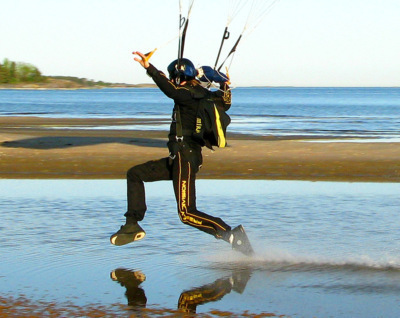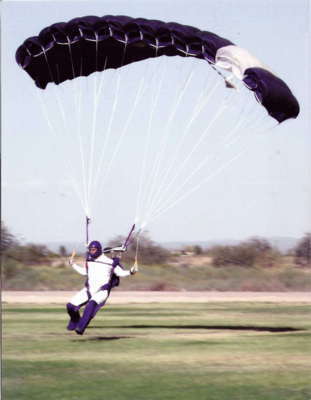Recommended Posts
fallman 0
First, it is important to restate that a tracking derby competition style track is different from the most efficient track possible. In the tracking derby an angle as steep as 45 degrees could produce the best results. Also, to reach the distances needed to place in these competitions you need to be tracking downwind, not many DZ's will want you tracking downwind especiallly with low jump numbers.
As far as improving your tracking goes, find a competent backtracker and have him lead small dives. I learned a lot by having a very proficient tracker lead dives and having him gradually increase speed throughout the dive and keeping pace with him.
Learn to track in formation as well. Groups are not a waste of your time. Having to keep a certain amount of speed while maneuvering side to side and up or down forces you to use vaious inputs. I first learned how to drop down on a formation, then applied the opposite body position to float. You will realise that simply spreading your fingers can effect your elevation, pointing your toes pushes you forward, etc... my point is that by learning the nuances of your track, especially through trying to build tracking formations you will understand what you are doing and you can manipulate your track further.
One thing that hasn't been mentioned is to try tracking without using your arms. Clasp your hands just below your boc and balance with just your legs. I guess my overall suggestion is to learn how each part of your body effects your track through experimentation, be patient. Not only will you fly more efficiently but at least in my case, i feel more as if I am 'flying' my body and I enjoy that more than anything else.
Most importantly, have fun.
woa....that was cool....
As far as improving your tracking goes, find a competent backtracker and have him lead small dives. I learned a lot by having a very proficient tracker lead dives and having him gradually increase speed throughout the dive and keeping pace with him.
Learn to track in formation as well. Groups are not a waste of your time. Having to keep a certain amount of speed while maneuvering side to side and up or down forces you to use vaious inputs. I first learned how to drop down on a formation, then applied the opposite body position to float. You will realise that simply spreading your fingers can effect your elevation, pointing your toes pushes you forward, etc... my point is that by learning the nuances of your track, especially through trying to build tracking formations you will understand what you are doing and you can manipulate your track further.
One thing that hasn't been mentioned is to try tracking without using your arms. Clasp your hands just below your boc and balance with just your legs. I guess my overall suggestion is to learn how each part of your body effects your track through experimentation, be patient. Not only will you fly more efficiently but at least in my case, i feel more as if I am 'flying' my body and I enjoy that more than anything else.
Most importantly, have fun.
woa....that was cool....
BMFin 0
Good advises here. 2-way 3-way, why not ?
But I also see the bigger tracking dives very helpful even though they wouldnt be that fast.
I.E. It is essential to learn how to get back up in the picture when you fall under. This you would not learn really on a 2-way.
Also I think it is easier to see the effects of your bodypositions relative to a big way, that does not forgive your mistakes.
Try everything.. Exit a little late and catch up etc..
But I also see the bigger tracking dives very helpful even though they wouldnt be that fast.
I.E. It is essential to learn how to get back up in the picture when you fall under. This you would not learn really on a 2-way.
Also I think it is easier to see the effects of your bodypositions relative to a big way, that does not forgive your mistakes.
Try everything.. Exit a little late and catch up etc..
my turnign point came when someone hosed me on a tracking dive and I just straightened my body out and took off and caught the formation and learned how to haul ass....
which is nice when big jumps go bad cause you can haul across the sky and get the fuck away
Cheers
Dave
which is nice when big jumps go bad cause you can haul across the sky and get the fuck away
Cheers
Dave
http://www.skyjunky.com
CSpenceFLY - I can't believe the number of people willing to bet their life on someone else doing the right thing.
CSpenceFLY - I can't believe the number of people willing to bet their life on someone else doing the right thing.
firstime 0
*** dont look below you feet behind you: if you do, you are probably pitched too much.
Well, you just corrected my problem.
Yes in deedy.
I owe you a cold one
Well, you just corrected my problem.
Yes in deedy.
I owe you a cold one
OSOK 0
Thanks guys. I'll dedicate a couple of dives to tracking without using my arms... I'm wondering how that would come out.
Thnx for all the answers!!
(if anyone comes down to Skydive Miami, and wanna track, PLZ look me up )
)
Thnx for all the answers!!
(if anyone comes down to Skydive Miami, and wanna track, PLZ look me up
QuoteFirst, it is important to restate that a tracking derby competition style track is different from the most efficient track possible. In the tracking derby an angle as steep as 45 degrees could produce the best results. Also, to reach the distances needed to place in these competitions you need to be tracking downwind, not many DZ's will want you tracking downwind especiallly with low jump numbers.
Hmm, I do not totally agree on that. On both a derby or a seperation track, you try to cover as much distance possible in the altitude you got. (best glide)
So the "only" difference is the altitude you can spend.
In other words, you will make it further if you slowly take more angle when your forward speed builds up, like in the the "derby style track" as you call it.
The extra speed you pick up creates lift, so your vertical speed wont increase that much and the extra distance you get in return is way higher, when done properly.
Try to play with that angle is what I would recommend to anybody wanting to improve tracking skillz. The body position your after is like lying flat on the ground, with your nose on the floor. Legs straight, toes pointed. Arms a little out to the side, for stability, but hands flat, thumbs pointing to the front. Dont arch or dearch, look to your toes, cup or roll your shoulders down as this will actually make your body less aerodynamic.
See this position as your wing and compare it to your canopy. If you want to go steaper, you take the leading edge of the wing down by pulling the front riser, so in freefall it means you have to push your leading edge down as well, being your head, shoulders and arms, and a little bit of torso. As soon as you feel you take more angle try to "lock" the angle your in by going back to your basic wing position. (you must love this sensation of speeding up!)
Going more flat is the other way around, pull that leading edge up.
Breaking on a canopy is done by pulling the tale down a bit, in your track you can do this by tucking your knees down in the relative wind, that will feel like its coming from the front and is hitting you on the head, not your belly.
This way you can adjust angle and speed seperately, making it possible to fly really precise with anybody within the thru range of your own body, offcourse you will have to practise first...
What a bummer
I uploaded two pictures of a jump we did last summer. This is what you're after, offcourse he had his head down here, but he had to smile to the camera
As you can see he is still a little bit in brakes, his knees push against the airflow, slowing him down.
Man, does this guy TAKE OFF when he smokes it.
JohnMitchell 16
That's called a delta. Gives some forward movement with some downward movement, made for diving down to the formation. By not pushing on the air with your arms, you pitch more head down. It's not an efficient way to move across the sky. But it does have it's uses.QuoteThanks guys. I'll dedicate a couple of dives to tracking without using my arms... I'm wondering how that would come out.
Remster 30
Quoteyou try to cover as much distance possible in the altitude you got
But thats not the metric for Derbies. Its as much distance in a specific time, not altitude.
Remster





Impressive.. Got video ?
Share this post
Link to post
Share on other sites